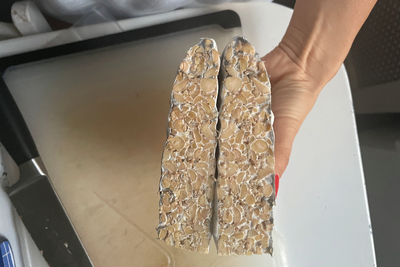
In her essay for Prism’s The Meat Issue, food writer Wei Tchou recounts how making tempeh from scratch helped her channel her angst and practice mindfulness. In other words, it was like a delicious version of therapy. Read the full recipe below and check out Wei’s signature tempeh and sprouts sandwich, too.

2 cups dried soybeans
½ cup sesame seeds (either roasted or raw are fine)*
1 Tbsp vinegar (white or rice vinegar)
1 tsp Cultures for Health tempeh starter
*If omitting sesame seeds, add in an extra ½ cup soybeans

- A stockpot
- A large wooden spoon
- A spider strainer
- A colander
- Paper towels
- 2 sheet trays
- A paring knife
- 1 large ziplock bag
- An oven thermometer
- A big mixing bowl

- Soak the soybeans overnight.
- Simmer the beans, until tender, about 45 min to 1½ hours.
- Let the beans come to room temperature, and use a large wooden spoon to agitate the beans against the walls of the pot, to loosen the skins from the beans. When the water has cooled off enough, use your hands to pick through the beans and pop them from their skins. I’m sorry, it’s arduous, I know. You can use a spider strainer every now and then to remove the hulls from the surface of the water.
- Once the beans are dehulled, drain them in a colander and transfer them in two batches to two paper towel-lined sheet trays and spread them in a single layer to dry. I like to position them near an open window. Check on them periodically and toss them around to help get all sides dry.
- While the beans are drying, use a paring knife to perforate the ziplock bag with many holes on a cutting board—one hole every centimeter, at the very least.
- Calibrate your oven: Place your oven thermometer on the grates and turn the oven light on. Figure out where about 85 to 90 degrees Fahrenheit is in your oven and hold it there. Some tricks you might use, if the oven isn’t warm enough: Stick an electric heating pad in there periodically, to warm it up. Stick a pan of boiling water in the base of the oven to warm it up.
- Once the beans are dry and cool, transfer them into a big mixing bowl. Stir in the sesame seeds, then the vinegar, then the tempeh starter.
- Fill the ziplock bag with the inoculated beans and spread the beans out in a layer about 1 inch to 1½ inches thick.
- Place the ziplock bag with the beans directly on the grates of your oven, with the oven light on. Make sure the radiant temperature of the oven is between 85 and 90 degrees.
- Check the tempeh every few hours to make sure you’re maintaining temperature and adjust if it gets too warm or too cold.
- Between 12 and 24 hours, the tempeh should start growing mycelium—fuzzy white patches—on its surface. When you spot this, you can go ahead and turn your oven light off. The tempeh will generate its own heat from here.
- Flip the tempeh, around 24 hours, to make sure the bottom is getting as much air circulation and opportunity to grow.
- Check the tempeh at 36 hours, and every few hours after that—take it out and smell it. So long as the beans are patchy and not yet completely bound together by a white mat, and so long as you don’t smell ammonia, you should be okay to continue growing. If you see gray or black spots, this is normal, but a sign that the tempeh has fully matured and should be taken out of fermentation and put into the fridge. The best-developed tempeh is marshmallow-like, its exterior fluffy and white, and should smell nutty. If it smells strongly of ammonia, it should be thrown out. 48 hours is the max time you should ferment tempeh.
- When you’re done, pull the tempeh out of the ziplock bag, slice it up, and put it in a sealed container. It will stay fresh in the refrigerator for a week.



Wei Tchou
Wei writes about culture, food, and nature. She lives in Brooklyn.
Prism asks: What is the most unique thing you’ve ever eaten?
“While I was reading The Omnivore’s Dilemma as an impressionable teenager, and clumsily rethinking my relationship to eating animals, I took a trip to the Ecuadorian Amazon. During a particularly arduous hike, my rainforest guide pulled up a long blade of grass, on which were a dozen or so small ants. He motioned for me to eat them, so I did. They tasted exactly like lemons. I would say this sums up my approach to plant-based eating—make good, righteous decisions about what you’re eating, when you can. But always eat the ants!”

Wellness stories you won’t find anywhere else.
